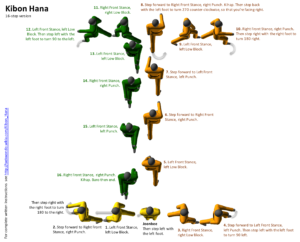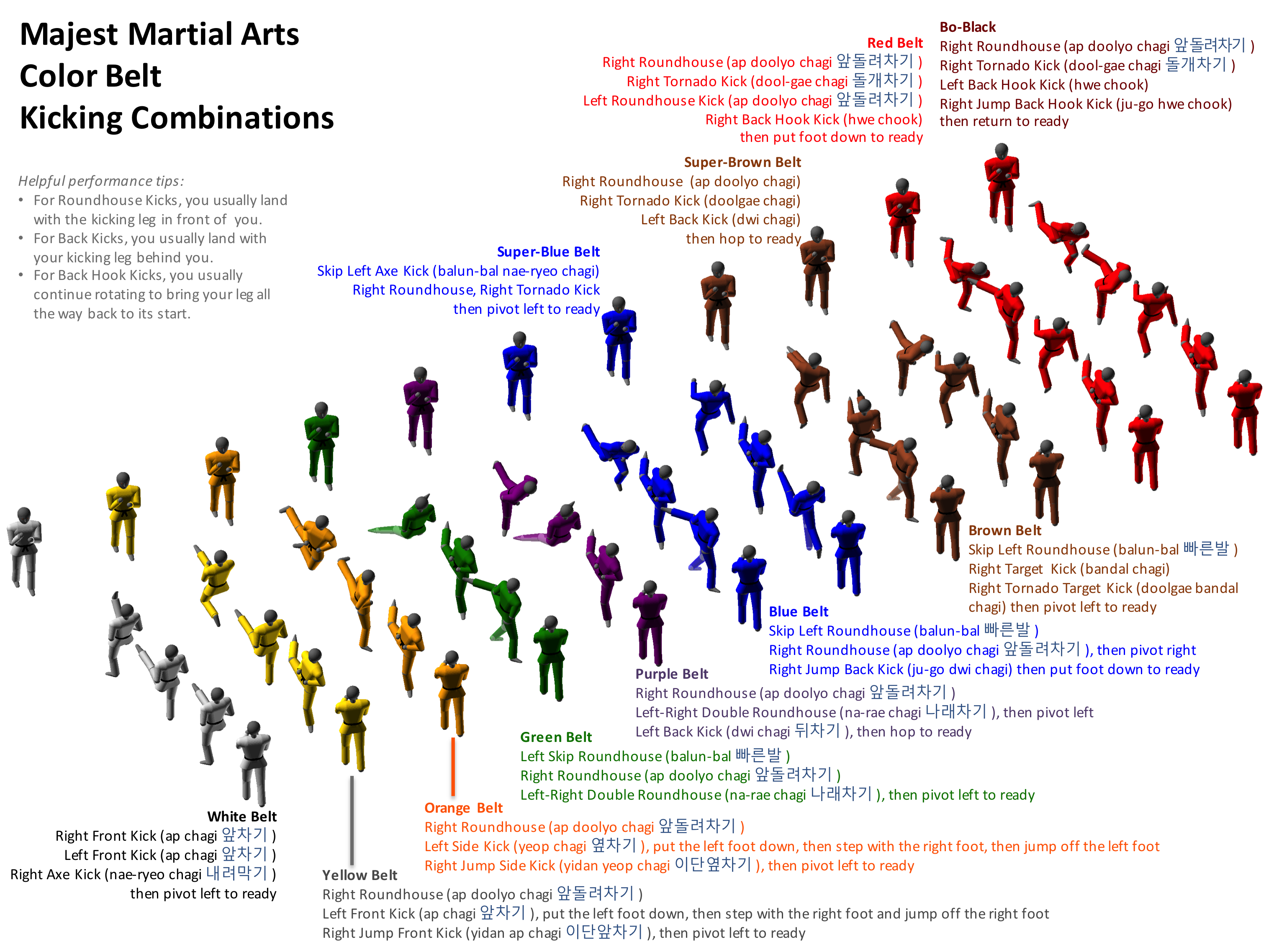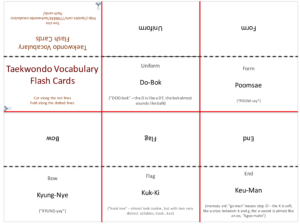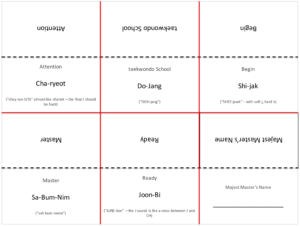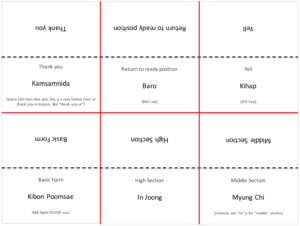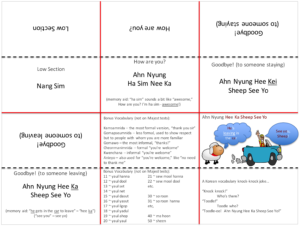White Belt Curriculum
Majest Martial ArtsAt Majest, belt promotion tests consist of six sections:
- A review of basic TaeKwonDo techniques (blocking, kicking, punching, etc.)
- A test of your ability to perform the associated taekwondo routine. In the Kukkiwon / WTF style that is practiced at Majest, these routines are called “poomsae” (poom-say). At Majest, White Belts practice the poomsae: Kibon Hana, which translates as “Basic #1”.
- A test of your ability to perform the associated kicking combination. At Majest, White belts practice the combination: front kick (ap chagi), front kick (ap chagi), axe kick (naeryeo chagi).
- For Yellow Belts and above (but not White Belts), there will be a test of the student’s sparring ability.
- A test of your ability to apply what you’ve learned via a board-break. At Majest, White belts gain confidence by breaking a board using a downward hammer-fist strike.
- Questions and Answers concerning your knowledge of TaeKwonDo
The following diagrams and videos illustrate the White Belt curriculum at Majest, the material that must be practiced for promotion to Yellow Belt. The poomsae that White Belts must practice is Kibon Hana:
How to read the above diagram: this diagram looks like an I-shape, but that’s just how these kinds of diagrams are drawn. Really the student turns left and moves through steps 1 and 2, then turns 180 right and retraces their steps at 3 and 4, and so on. Note that this diagram shows only the first 16 steps of Kibon Hana — the final four steps simply repeat the starting line.
Kibon Hana teaches three of the most basic movements of TaeKwonDo: the long front stance, the low block, and the middle punch. The key here is not just “finishing” the movement properly, but also starting the movement properly with the correct chamber. In TaeKwonDo the word chamber means putting one’s hands or feet in the correct position at the outset of a movement, so that the subsequent movement can be performed with snap and power.
Most importantly, this form teaches students how to move while maintaining a stance: how to turn, how to step forward, etc. Getting into a stance position is relatively straightforward, but learning to step and turn while maintaining a stance can requires months of practice to perform well. You can read more about Kibon Hana, including step-by-step instructions, here: Kibon Hana. In addition, the videos below demonstrate how to perform the Kibon Hana, the Majest White Belt kicking combination, and the Majest White Belt breaking technique.
10th gup - the White Belt "Six Step" routine
Even before students learn Kibon Hana at Majest, they practice the “six step” form, which teaches students how to get into the correct posture for blocking and striking drills.
10th gup - White Belt, Kibon Hana (showing the stances only)
This video shows just the stances used in Kibon Hana (not the hand movements). Often we practice the Kibon Hana routine using just the stances, to teach students the correct foot movements — especially the turns. Once the stance movements are correct, we can then practice the associated hand movements (blocks and punches).
Important note: when we’re teaching students new forms, we often teach them to move into their stance first, then perform the associated hand motion: step, then block; step, then punch; etc. Once a student has memorized the form, these movements should be simultaneous: the blocking motion concludes exactly when the stepping motion concludes; the punching motion concludes exactly when the stepping motion concludes, etc.
10gup - White Belt, Kibon Hana (step by step)
This video shows the Kibon Hana routine, but in a slow, step-by step fashion.
10gup - White Belt, Kibon Hana (with written instructions)
This video shows the Kibon Hana routine, but in a slow, step-by step fashion, with instructions embedded in the video.
10th gup - White Belt, Kibon Hana (full speed)
This is the full Kibon Hana poomsae (routine) that White Belts must learn to perform to progress to Yellow Belt at Majest.
10th gup - White Belt breaking
White Belts must learn to break a board with a Downward Hammerfist Strike in order to progress to Yellow Belt. There are three kihaps (yells) required in any board-breaking routine: 1. to get ready for the break; 2. at the moment of impact; and 3. to conclude the break.
10th gup - White Belt kicking combination
White Belts must learn the kicking routine shown here in order to progress to Yellow Belt. Front Kick (ap chagi) with the right leg, then Front Kick (ap chagi) with the left leg, then Naeryeo Chagi (axe kick) with the right leg – then turn 180 when finished.
10th gup - How Parents Can Help
Here are things you as a parent can do to help your child with White Belt (10th gup) homework:
- Use a doll or action figure to trace out the floor-pattern of the Kibon Hana poomsae. Starting at the ready position (“joonbee”), turn left, step forward. Turn 180 right, step forward. Turn 90 left, step forward three times and kihap (yell) on the last step, etc.
- Stretching – gently start helping your child with hamstring stretches and splits — the two most important stretches in taekwondo. From a seated position with both legs straight out in front, no bend in the knees, feet together, help your child touch his or her toes. Once the hamstrings are stretched, have the seated child spread one leg to either side (splits) and lean forward, then to the left, then to the right, then forward again. This is something you and your child can do together! Make this a daily or every-other-day habit while your child is practicing taekwondo, and you will be amazed at how quickly they improve! Note that warm muscles stretch best (not cold muscles) so the best time to stretch is after the child has been running-around playing. And as always, safety first – be gentle with the stretching.
- Have your child perform the poomsae for you at home. Some things to look for:
- Help your child learn to make a correct fist. The fingers should be curled closed, but not clenched until the moment of impact. The thumb should be placed along the end knuckles of the fingers, not curled inside the first.
- Help your child learn to punch. The fist starts palm-up at the hip, then rotates forward to finish palm-down at solar-plexus height. Simultaneously, the other hand starts by aiming loosely forward, then pulls back sharply to finish palm-up at the hip.
- Help your child learn the long stance. Despite the name, the stance doesn’t really need to be that “long” — what’s important here is that the back leg is perfectly straight (no bend at the knee) but the front leg has a bent knee so that the front shin is perpendicular to the ground.
- Make sure the chambering for the Low Block is done correctly. The fleshy base of the fist should be placed on the collar-bone at the outset of the block.
- Obtain a copy of the Majest White Belt test questions well before the test, and practice the test questions (including the Korean vocabulary) with your child. Print, cut-out, and fold the flashcards below for vocabulary help.









